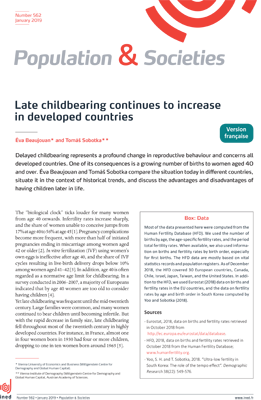Late childbearing continues to increase
in developed countries
Press release Published on 21 January 2019
Population & Societies n° 562, January 2019

Authors: Éva Beaujouan and Tomáš Sobotka
Delayed childbearing represents a profound change in reproductive behaviour and concerns all developed countries. One of its consequences is a growing number of births to women aged 40 and over. Éva Beaujouan and Tomáš Sobotka compare the situation today in different countries, situate it in the context of historical trends, and discuss the advantages and disadvantages of having children later in life.
Broad societal and cultural changes since the 1970s have provided incentives for young people to postpone parenthood. The greater access to and longer pursuit of higher education, the greater involvement of women in the labour market, and changes in family behaviour have contributed to a long-term increase in age at parenthood. The spread of effective contraception and wider access to abortion have also played a part, helping women and couples better plan the timing of births. Using data from the Human Fertility Database, the authors document a rise in fertility rates among women aged 40 and older in low-fertility countries of Europe, East Asia, North America, and Australia.
In the past, few women had their first or second child at age 40 or higher in these countries. Most “older mothers” would give birth to their fourth, fifth, or later child. Today, however, the majority of births to older mothers in most countries are first and second births. Late parenthood is likely to continue its upward trend. As childbearing past age 40 becomes ever more common, it is important for women and men to be better informed about the advantages and disadvantages involved in having children later in life.
Published on: 23/01/2019








